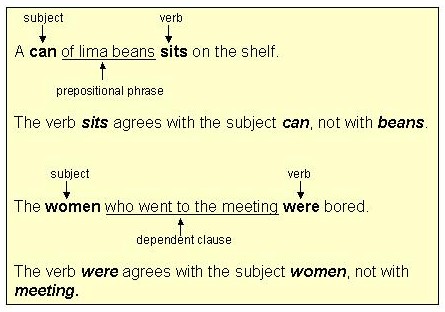Subjects and verbs must AGREE with one another in number (singular or plural). Thus, if a subject is singular, its verb must also be singular; if a subject is plural, its verb must also be plural.
In present tenses, nouns and verbs form plurals in opposite ways:
nouns ADD an s to the singular form,
BUT
verbs REMOVE an s from the singular form.

Here are nine subject-verb agreement rules.
1. A phrase or clause between subject and verb does not change the number of the subject.
Examples:

2. Indefinite pronouns as subjects
- Singular indefinite pronoun subjects take singular verbs.

- Plural indefinite pronoun subjects take plural verbs.
PLURAL: several, few, both, many

- Some indefinite pronouns may be either singular or plural: with uncountable, use singular; with countable, use plural.
EITHER SINGULAR OR PLURAL: some, any, none, all, most

Sugar is uncountable; therefore, the sentence has a singular verb.

Marbles are countable; therefore, the sentence has a plural verb.
3. Compound subjects joined by and are always plural.

4. With compound subjects joined by or/nor, the verb agrees with the subject nearer to it.

In the above example, the plural verb are agrees with the nearer subject actors.

In this example, the singular verb is agrees with the nearer subject director.
5. Inverted Subjects must agree with the verb.


6. Collective Nouns (group, jury, crowd, team, etc.) may be singular or plural, depending on meaning.

In this example, the jury is acting as one unit; therefore, the verb is singular.

In this example, the jury members are acting as twelve individuals; therefore, the verb is plural.
7. Titles of single entities (books, organizations, countries, etc.) are always singular.

8. Plural form subjects
- Plural form subjects with a singular meaning take a singular verb. (e.g. news, measles, mumps, physics, etc.)

- Plural form subjects with singular or plural meaning take a singular or plural verb, depending on meaning. (e.g. politics, economics, etc.)

In this example, politics is a single topic; therefore, the sentence has a singular verb.

In this example, politics refers to the many aspects of the situation; therefore, the sentence has a plural verb.
- Plural form subjects with a plural meaning take a plural verb. (e.g. scissors, trousers)


Note: In this example, the subject of the sentence is pair; therefore, the verb must agree with it. (Because scissors is the object of the preposition, scissors does not affect the number of the verb.)
9. With subject and subjective complement of different number, the verb always agrees with the subject.


10-A. With one of those ________ who, use a plural verb.

The above example implies that others besides Hannah like to read comic books. Therefore, the plural verb is the correct form to use.
10-B. With the only one of those ________who, use a singular verb.

The above example implies that no one else except for Hannah likes to read comic books. Therefore, the singular verb is the correct for to use.
11-A. With the number of _______, use a singular verb.

11-B. With a number of _______, use a plural verb.

12. With every ______ and many a ________, use a singular verb.




